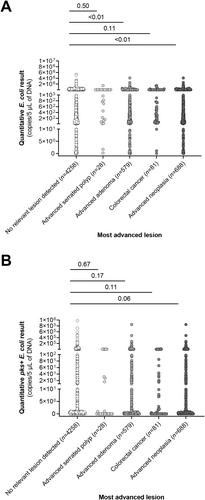Polyketide synthase positive Escherichia coli one-time measurement in stool is not informative of colorectal cancer risk in a screening setting
Willemijn de Klaver, Meike de Wit, Anne Bolijn, Marianne Tijssen, Pien Delis-van Diemen, Margriet Lemmens, Manon CW Spaander, Evelien Dekker, Monique E van Leerdam, Veerle MH Coupé, Ruben van Boxtel, Hans Clevers, Beatriz Carvalho, Gerrit A Meijer
下载PDF
{"title":"Polyketide synthase positive Escherichia coli one-time measurement in stool is not informative of colorectal cancer risk in a screening setting","authors":"Willemijn de Klaver, Meike de Wit, Anne Bolijn, Marianne Tijssen, Pien Delis-van Diemen, Margriet Lemmens, Manon CW Spaander, Evelien Dekker, Monique E van Leerdam, Veerle MH Coupé, Ruben van Boxtel, Hans Clevers, Beatriz Carvalho, Gerrit A Meijer","doi":"10.1002/path.6276","DOIUrl":null,"url":null,"abstract":"<p>Environmental factors like the pathogenicity island <i>polyketide synthase positive (pks+) Escherichia coli</i> (<i>E. coli</i>) could have potential for risk stratification in colorectal cancer (CRC) screening. The association between <i>pks+ E. coli</i> measured in fecal immunochemical test (FIT) samples and the detection of advanced neoplasia (AN) at colonoscopy was investigated. Biobanked FIT samples were analyzed for both presence of <i>E. coli</i> and <i>pks+ E. coli</i> and correlated with colonoscopy findings; 5020 CRC screening participants were included. Controls were participants in which no relevant lesion was detected because of FIT-negative results (cut-off ≥15 μg Hb/g feces), a negative colonoscopy, or a colonoscopy during which only a nonadvanced polyp was detected. Cases were participants with AN [CRC, advanced adenoma (AA), or advanced serrated polyp (ASP)]. Existing DNA isolation and quantitative polymerase chain reaction (qPCR) procedures were used for the detection of <i>E. coli</i> and <i>pks+ E. coli</i> in stool. A total of 4542 (90.2%) individuals were <i>E. coli</i> positive, and 1322 (26.2%) were <i>pks+ E. coli</i> positive. The prevalence of <i>E. coli</i> in FIT samples from individuals with AN was 92.9% compared to 89.7% in FIT samples of controls (<i>p</i> = 0.010). The prevalence of <i>pks+ E. coli</i> in FIT samples from individuals with AN (28.6%) and controls (25.9%) was not significantly different (<i>p</i> = 0.13). The prevalences of <i>pks+ E. coli</i> in FIT samples from individuals with CRC, AA, or ASP were 29.6%, 28.3%, and 32.1%, respectively. In conclusion, the prevalence of <i>pks+ E. coli</i> in a screening population was 26.2% and did not differ significantly between individuals with AN and controls. These findings disqualify the straightforward option of using a snapshot measurement of <i>pks+ E. coli</i> in FIT samples as a stratification biomarker for CRC risk. © 2024 The Authors. <i>The Journal of Pathology</i> published by John Wiley & Sons Ltd on behalf of The Pathological Society of Great Britain and Ireland.</p>","PeriodicalId":232,"journal":{"name":"The Journal of Pathology","volume":"263 2","pages":"217-225"},"PeriodicalIF":5.6000,"publicationDate":"2024-03-29","publicationTypes":"Journal Article","fieldsOfStudy":null,"isOpenAccess":false,"openAccessPdf":"https://onlinelibrary.wiley.com/doi/epdf/10.1002/path.6276","citationCount":"0","resultStr":null,"platform":"Semanticscholar","paperid":null,"PeriodicalName":"The Journal of Pathology","FirstCategoryId":"3","ListUrlMain":"https://onlinelibrary.wiley.com/doi/10.1002/path.6276","RegionNum":2,"RegionCategory":"医学","ArticlePicture":[],"TitleCN":null,"AbstractTextCN":null,"PMCID":null,"EPubDate":"","PubModel":"","JCR":"Q1","JCRName":"ONCOLOGY","Score":null,"Total":0}
引用次数: 0
引用
批量引用
Abstract
Environmental factors like the pathogenicity island polyketide synthase positive (pks+) Escherichia coli (E. coli ) could have potential for risk stratification in colorectal cancer (CRC) screening. The association between pks+ E. coli measured in fecal immunochemical test (FIT) samples and the detection of advanced neoplasia (AN) at colonoscopy was investigated. Biobanked FIT samples were analyzed for both presence of E. coli and pks+ E. coli and correlated with colonoscopy findings; 5020 CRC screening participants were included. Controls were participants in which no relevant lesion was detected because of FIT-negative results (cut-off ≥15 μg Hb/g feces), a negative colonoscopy, or a colonoscopy during which only a nonadvanced polyp was detected. Cases were participants with AN [CRC, advanced adenoma (AA), or advanced serrated polyp (ASP)]. Existing DNA isolation and quantitative polymerase chain reaction (qPCR) procedures were used for the detection of E. coli and pks+ E. coli in stool. A total of 4542 (90.2%) individuals were E. coli positive, and 1322 (26.2%) were pks+ E. coli positive. The prevalence of E. coli in FIT samples from individuals with AN was 92.9% compared to 89.7% in FIT samples of controls (p = 0.010). The prevalence of pks+ E. coli in FIT samples from individuals with AN (28.6%) and controls (25.9%) was not significantly different (p = 0.13). The prevalences of pks+ E. coli in FIT samples from individuals with CRC, AA, or ASP were 29.6%, 28.3%, and 32.1%, respectively. In conclusion, the prevalence of pks+ E. coli in a screening population was 26.2% and did not differ significantly between individuals with AN and controls. These findings disqualify the straightforward option of using a snapshot measurement of pks+ E. coli in FIT samples as a stratification biomarker for CRC risk. © 2024 The Authors. The Journal of Pathology published by John Wiley & Sons Ltd on behalf of The Pathological Society of Great Britain and Ireland.
在筛查过程中,一次性测量粪便中的多酮合成酶阳性大肠埃希氏菌并不能说明患结直肠癌的风险。
致病性岛屿多酮合成酶阳性(pks+)大肠杆菌(E. coli)等环境因素有可能在结肠直肠癌(CRC)筛查中用于风险分层。我们研究了粪便免疫化学检验(FIT)样本中检测到的 pks+ 大肠杆菌与结肠镜检查中检测到的晚期肿瘤(AN)之间的关联。研究人员对生物库中的 FIT 样本进行了大肠杆菌和 pks+ 大肠杆菌分析,并将其与结肠镜检查结果进行了关联;研究共纳入了 5020 名儿童癌症筛查参与者。对照组为因 FIT 阴性结果(临界值≥15 μg Hb/g 粪便)、结肠镜检查阴性或结肠镜检查仅发现非晚期息肉而未发现相关病变的参与者。病例为有 AN 的参与者[CRC、晚期腺瘤(AA)或晚期锯齿状息肉(ASP)]。采用现有的 DNA 分离和定量聚合酶链反应(qPCR)程序检测粪便中的大肠杆菌和 pks+ 大肠杆菌。共有 4542 人(90.2%)对大肠杆菌呈阳性,1322 人(26.2%)对 pks+ 大肠杆菌呈阳性。AN患者FIT样本中大肠杆菌的感染率为92.9%,而对照组FIT样本中大肠杆菌的感染率为89.7%(P = 0.010)。AN患者FIT样本中pks+大肠杆菌的流行率(28.6%)与对照组(25.9%)无显著差异(p = 0.13)。在 CRC、AA 或 ASP 患者的 FIT 样本中,pks+ 大肠杆菌的流行率分别为 29.6%、28.3% 和 32.1%。总之,筛查人群中 pks+ 大肠杆菌的流行率为 26.2%,且 AN 患者与对照组之间没有显著差异。这些发现否定了使用 FIT 样本中 pks+ 大肠杆菌的快照测量作为 CRC 风险分层生物标志物的直接方案。© 2024 作者。病理学杂志》由约翰威利父子有限公司代表大不列颠及爱尔兰病理学会出版。
本文章由计算机程序翻译,如有差异,请以英文原文为准。



